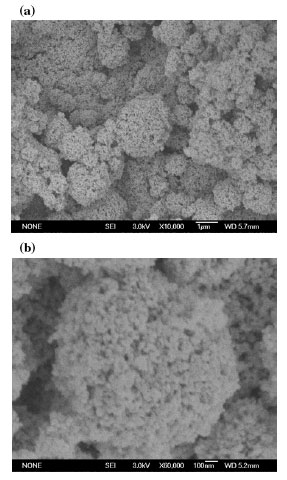| Posted: Apr 06, 2006 | |
Micro/nano composite structure enhances performance of solar cells |
|
| (Nanowerk News) A group of Chinese researchers prepared dye-sensitized solar cells using micro/nanocomposite TiO2 porous films, resulting in cells with enhanced light collection. They applied a technique which can produce a large area in continuous fabrication. This technique opens an alternative way for manufacturing solar cells on an industrial scale. | |
| With an increased focus on alternative sources of cheap, abundant, clean energy, solar cells are receiving lots of attention. The dye sensitized solar cell (DSSC) is one of the most important developments in photovoltaics in the last two decades. In our Nanowerk Spotlight of March 6, 2006 we explored DSSCs and new ways of improving them. | |
| The Chinese researchers published a paper, titled "TiO2 micro/nano-composite structured electrodes for quasi-solid-state dye-sensitized solar cells" in the March 28, 2006 online edition of Nanotechnology. | |
| Dr. Jin Zhai from the Institute of Chemistry at the Chinese Academy of Sciences explained to Nanowerk: "We successfully applied micro/nano-composite TiO2 porous films, that we prepared by the electro-hydrodynamic (EHD) technique, to dye sensitized solar cells." | |
| This is relevant because DSSCs are photovoltaic devices with liquid electrolytes, the presence of which may result in less long-term operation and practical limitations of sealing and leakage. Therefore a fabrication process that replaces the liquid electrolytes for quasi-solid-state and solid-state DSSCs is desirable. | |
| "However" Zhai says, "the penetration of quasi-solid or solid electrolytes into the TiO2 nanocrystalline network structures is a key problem that hampers the increase of the fill factor and the total conversion efficiency." | |
 |
The Chinese research group (Zhai and his co-researchers Yong Zhao, Lifang Wang and Daoben Zhu from the Chinese Academy of Sciences, as well as Shuxin Tan and Lei Jiang from the National Center for Nanoscience and Nanotechnology in Beijing) demonstrated that their composite nanoporous TiO2 films are better for the filling of ionic liquid and quasi-solid-state electrolytes than liquid state electrolytes. "The excellent fill factors for both ionic liquid (78.9%) and quasi-solid state electrolyte (75.3%) demonstrated that the composite hierarchical structures as photo-anodes in DSSC devices benefited the penetration of viscid electrolytes and provided powerful channels for the transport of the redox couple as a result" says Zhai. "Moreover, the micro/nano-composite structure maybe of benefit for light collection because of strong light scattering. Therefore, the micro/nano-composite structure played a very important role to enhance the photo-electric performance of solar cells." The EHD technique used by the researchers is widely applied for instance in membrane technology and biosensors. It is a simple fabrication method for nanofibers from organic, inorganic and hybrid compounds. During their experiments the researchers also found that adding an amount of polymer and changing the concentration of the polymer during the EHD process changes the specific surface area of the films; which leads to different photovoltaic behavior of solar cells. |
| (a) SEM image of TiO2 composite porous films prepared from the EHD process. (b) The magnified image. (Reprinted with permission from IoP Publishing) | |
| Zhai concludes: "Although the conversion efficiencies obtained by our micro/nano-composite films do not attain those of the reported standard method, we believe that there is enormous scope for further improvement by optimizing the composition of the precursor solution and electro-hydrodynamic parameters." | |
| The EHD process described by the Chinese researchers could be extended to provide an ordinary method to make the films of other oxides such as ZnO or Al2O3. The usefulness of the resulting films extends beyond DSSCs to many other applications such as catalysts, sensors, or water purification. | |
 By
Michael
Berger
– Michael is author of three books by the Royal Society of Chemistry:
Nano-Society: Pushing the Boundaries of Technology,
Nanotechnology: The Future is Tiny, and
Nanoengineering: The Skills and Tools Making Technology Invisible
Copyright ©
Nanowerk LLC
By
Michael
Berger
– Michael is author of three books by the Royal Society of Chemistry:
Nano-Society: Pushing the Boundaries of Technology,
Nanotechnology: The Future is Tiny, and
Nanoengineering: The Skills and Tools Making Technology Invisible
Copyright ©
Nanowerk LLC
|
|
Become a Spotlight guest author! Join our large and growing group of guest contributors. Have you just published a scientific paper or have other exciting developments to share with the nanotechnology community? Here is how to publish on nanowerk.com.
